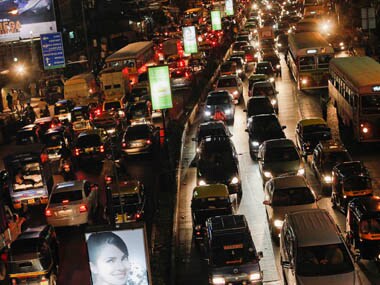A couple of years ago, Enrique Penalosa, the dynamic former Mayor of Bogota in Colombia who improved on the world-renowned “bus rapid transit system” or BRTS initiated in Curitiba in Brazil, addressed a Mumbai audience. He admitted, with heavy sarcasm, that he was unfamiliar with the Indian Constitution, but he wasn’t aware if there was a fundamental right to drive - or for that matter to park - in cities here.
One should never underestimate the power of the motorists’ lobby, particularly in our two mega cities, which believes that it has such rights. It will not concede that it is actually being subsidised from the public exchequer to ply polluting vehicles.
However, there is another perspective which may help the authorities to curb the senseless proliferation of motorised transport. This is the threat to public health: if it is the mortality of citizens that is at stake, this may well galvanise the state to act. The Centre for Science & Environment (CSE) in the capital has just brought out its book titled Good News Bad News: Clearing the air in Indian cities which warns in no uncertain terms about air quality.
It will come as a shock to learn that air pollution accounts for the fifth highest toll of lives and the seventh biggest illness burden in India, according the Global Burden of Disease report, released this year. While much of air pollution nation-wide is due to the burning of smoky cooking fuels, in cities the situation is exacerbated by pollutants from diesel and petrol burnt in cars. Data from the Indian Council of Medical Research this year also indicates the high incidence of lung cancer in cities.
[caption id=“attachment_1153129” align=“alignleft” width=“380”]  Vehicles are seen in a traffic jam during rush hour in Mumbai. Reuters[/caption]
For politicians who have yearned for years to make Mumbai “a world-class city”, the pollution and traffic jams will put paid to any such delusion. The CSE, which has long campaigned particularly against “dirty diesel” in Delhi, once had a poster which exhorted the Prime Minister to roll down his car window to realise that the real threat was not from across our borders but from the air we breathe.
As it happens, Mumbai and Pune have vibrant citizens’ movements which are pushing for better public transport, even while simultaneously placing curbs on private motorised modes. Although the Brazilian BRTS is usually dismissed by officials as being unsuitable for Indian cities given the narrow widths of even arterial roads, the fact remains that a reserved air-conditioned bus lane, with easy access for passengers and high frequency, is the cheapest mode of city transport. It inevitably means that motorists will be squeezed into the more congested remaining lanes.
It is due to the snarls on the roads that commuters are increasingly deserting buses for two- or even four-wheelers. In the capital, the proportion of bus passengers has dropped from 60 percent in 2000 to 41 percent now. And the two really environment - and people-friendly modes of transport - cycling and walking are getting short shrift. Even so, Delhi has the largest number of cyclists, whereas 55 percent of Mumbaikars walk to work, according to World Bank data. Inexplicably, Kolkata is in fact trying to ban cycles.
As the CSE notes, every year, Delhi needs an area the size of 310 football fields for parking its vehicles. Chennai needs 100 such fields, Chandigarh 58 and Bhubaneswar 30. Much earlier, it had calculated that a car needs an average of 23 sq metres of space to access parking three times daily - at home, at work and for leisure. If one multiplied the number of cars by this area, it would approximate the area occupied in Delhi by slum dwellers. Who are vilified in the public imagination?
Since leaders have often fantasised about making Mumbai another Singapore or Shanghai, they should heed another of the CSE’s findings. As is now well documented, China - the world’s biggest carbon dioxide gas emitter - is belatedly taking steps to ensure that its cities don’t become unlivable. It was in the global radar particularly during the 2008 Beijing Olympics when officials feared that some events may have been called off due to the polluted air.
A country now seen undeterred in its pursuit of mammon has seen “a most dramatic turnaround”. Beijing and Shanghai have actually put a cap on the cars bought every year. The capital permits only 240,000 a year - as against a demand for six times as many. Singapore has an even more calibrated system, where anyone who wants to buy a car has to wait till someone is selling one, and the special ownership fee is determined by demand.
In India, the carrot for improving urban transport lies in providing better public modes - buses, trains and metros. These three are listed in order of their priority, though admittedly, Mumbai’s geography makes the train the ideal system. According to Penalosa, there is no city in the world, with the exception of Mexico City, where a metro carries the majority of commuters. Even London, the oldest, witnesses more trips made by bus than on the underground, albeit these are shorter. Fares put the metro out of range for the urban poor in our cities. Mumbai’s 7 million rail commuters can’t all go underground.
However, there is also need of the stick in deterring car usage. The Bangalore municipality has just stolen a march over other cities by imposing a fee of Rs 30 per hour in the central business district for cars and half as much for two-wheelers.
Despite demands by public transport lobbies in Mumbai to do likewise, the authorities are dithering.
Campaigners have called for telescopic charges, where the fees increase with time, fees for night parking, heavier penalties for parking on major roads and making it compulsory for building societies to provide parking within their premises.


)
)
)
)
)
)
)
)
)



